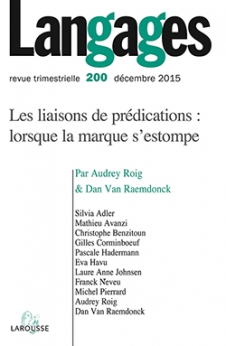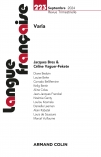
Langages n° 200 (4/2015)
Pour acheter ce numéro, contactez-nous
Recevez les numéros de l'année en cours et accédez à l'intégralité des articles en ligne.
L’objectif de notre contribution est d’identifier la nature du lien syntaxique et sémantique qui s’établit entre les concessives extensionnelles en aussi/si Adjectif (que) et leurs phrases matrices. Ces structures sont doublement intéressantes : elles présentent une grande variation formelle – avec une alternance entre aussi/si et entre que P/P avec inversion du sujet – d’une part et posent problème pour ce qui est de l’identification du rapport qui existe entre les deux parties de l’énoncé d’autre part. Nous montrerons que, tant au sein de la concessive que dans son rapport avec la phrase matrice, il existe un lien qui peut être qualifié d’hypotaxique. Nous mettrons également en évidence que l’inversion du sujet, bien qu’elle relève d’une stratégie discursive spécifique, participe à l’intégration et à la dépropositionnalisation de la séquence dans laquelle elle se manifeste et la verse ainsi également du côté de l’hypotaxe.
The aim of our paper is to identify the nature of the syntactic and semantic relationship between universal concessives in aussi/si Adjectif (que) and their matrix clauses. These structures are highly interesting because they are characterized by a wide variation in realisations of the clause introduced by the marker on the one hand and because they are problematic in terms of identifying the relationship between the two parts of the utterance on the other hand. We will show that within the concessive and also in its relation matrix clause, there is a form of linkage that can be described as hypotactic. We will also demonstrate that the inversion of the subject, although it is part of a specific discourse strategy, is involved in the integration and desententialisation mechanisms of the sequence in which it occurs and thus orients towards hypotaxis.

